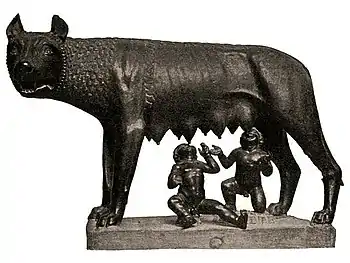Leopard
The leopard (Panthera pardus) is one of the five extant species in the genus Panthera, a member of the Felidae.[4] It occurs in a wide range in sub-Saharan Africa, in small parts of Western and Central Asia, a small part of European Russia, and on the Indian subcontinent to Southeast and East Asia. It is listed as Vulnerable on the IUCN Red List because leopard populations are threatened by habitat loss and fragmentation, and are declining in large parts of the global range. In Hong Kong, Singapore, South Korea, Jordan, Morocco, Togo, the United Arab Emirates, Uzbekistan, Lebanon, Mauritania, Kuwait, Syria, Libya, Tunisia and most likely in North Korea, Gambia, Laos, Lesotho, Tajikistan, Vietnam, and Israel, leopard populations have already been extirpated.[2] Contemporary records suggest that the leopard occurs in only 25% of its historical global range.[5][6]
| Leopard Temporal range: Early Pleistocene to recent[1] | |
|---|---|
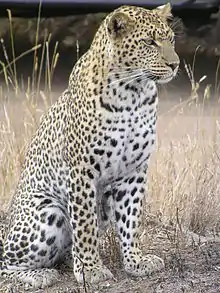 | |
| A leopard in Serengeti National Park | |
| Scientific classification | |
| Kingdom: | Animalia |
| Phylum: | Chordata |
| Class: | Mammalia |
| Order: | Carnivora |
| Suborder: | Feliformia |
| Family: | Felidae |
| Subfamily: | Pantherinae |
| Genus: | Panthera |
| Species: | P. pardus[3] |
| Binomial name | |
| Panthera pardus[3] | |
| Subspecies | |
|
See text | |
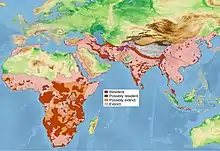 | |
| Present and historical distribution of the leopard[2] | |
Compared to other wild cats, the leopard has relatively short legs and a long body with a large skull. Its fur is marked with rosettes. It is similar in appearance to the jaguar, but has a smaller, lighter physique, and its rosettes are generally smaller, more densely packed and without central spots. Both leopards and jaguars that are melanistic are known as black panthers. The leopard is distinguished by its well-camouflaged fur, opportunistic hunting behaviour, broad diet, strength, and its ability to adapt to a variety of habitats ranging from rainforest to steppe, including arid and montane areas. It can run at speeds of up to 58 kilometres per hour (36 mph).[7] The earliest known leopard fossils excavated in Europe are estimated 600,000 years old, dating to the late Early Pleistocene.[1] Leopard fossils were also found in Japan[8] and Sumatra.[9]
Etymology
The English name 'leopard' comes from Old French: leupart or Middle French: liepart, that derives from Latin: leopardus and Ancient Greek: λέοπάρδος (leopardos). Leopardos could be a compound of λέων (leōn), meaning lion, and πάρδος (pardos).[10][11][12] The word λέοπάρδος originally referred to a cheetah.[13]
'Panther' is another common name, derived from Latin: panther and Ancient Greek: πάνθηρ (pánthēr);[10] The generic name Panthera originates in Latin: panthera, which refers to a hunting net for catching wild beasts that were used by the Romans in combats.[14] The phonetically similar Sanskrit: पाण्डर (pând-ara) means pale yellow, whitish or white.[15] The specific name Latin: pardus refers to a male panther.[16] The word pardus is thought to originate from Ancient Greek: παρδάλωτός (pardalotόs) meaning spotted like a leopard.[17]
Characteristics
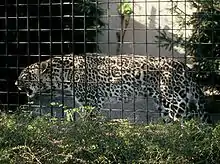
The leopard's fur is generally soft and thick, notably softer on the belly than on the back.[18] Its skin colour varies between individuals from pale yellowish to dark golden with dark spots grouped in rosettes. Its belly is whitish and its ringed tail is shorter than its body. Its pupils are round.[19] Leopards living in arid regions are pale cream, yellowish to ochraceous and rufous in colour; those living in forests and mountains are much darker and deep golden. Spots fade toward the white underbelly and the insides and lower parts of the legs.[20] Rosettes are circular in East African leopard populations, and tend to be squarish in Southern African and larger in Asian leopard populations. The fur tends to be grayish in colder climates, and dark golden in rain forest habitats.[7] The pattern of the rosettes is unique in each individual.[21][22]
Its fur tends to grow longer in colder climates.[23] The guard hairs protecting the basal hairs are short, 3–4 mm (1⁄8–5⁄32 in) in face and head, and increase in length toward the flanks and the belly to about 25–30 mm (1–1 1⁄8 in). Juveniles have woolly fur, and appear to be dark-coloured due to the densely arranged spots.[21][24] Its white-tipped tail is about 60–100 cm (24–39 in) long, white underneath and with spots that form incomplete bands toward the tail's end.[25] The leopard's rosettes differ from those of the jaguar, which are darker and with smaller spots inside. The cheetah has small round spots without any rosettes.[19]
Like most cat species, the leopard has a diploid chromosome number of 38.[26] The chromosomes include four acrocentric, five metacentric, seven submetacentric and two telocentric pairs.[27]
Skull
The largest skull recorded for a black panther from India, recorded in 1920, measured 28 cm (11 in) in basal length, and 20 cm (8 in) in breadth, and weighed 1,000 g (2 lb 4 oz). The skull of a West African panther measured 28.6 cm (11 1⁄4 in) in basal length, and 18.1 cm (7 1⁄8 in) in breadth, and weighed 790 g (1 lb 12 oz).[28]
Size and weight
The leopard is sexually dimorphic, males are larger and heavier than females.[25] It is muscular, with relatively short limbs and a broad head. Males stand 60–70 cm (23 1⁄2–27 1⁄2 in) at the shoulder, while females are 57–64 cm (22 1⁄2–25 in) tall. The head-and-body length ranges between 90 and 196 cm (2 ft 11 1⁄2 in and 6 ft 5 in) with a 66-to-102-centimetre-long (26 to 40 in) tail. Sizes vary geographically.[23] Males weigh 37–90 kg (82–198 lb), and females 28–60 kg (62–132 lb).[24][29]
Some leopards in North Africa allegedly were as large as Barbary lions. In 1913, an Algerian newspaper reported a leopard killed that allegedly measured about 275 cm (9 ft 0 in) in total length.[30]
The maximum weight of a wild leopard in Southern Africa was about 96 kg (212 lb). It measured 262 cm (8 ft 7 in).[31] An Indian leopard killed in Himachal Pradesh in 2016 measured 261 cm (8 ft 7 in) with an estimated weight of 78.5 kg (173 lb); it was perhaps the largest known wild leopard.[32][33]
Variant colouration

Melanistic leopards are also called black panthers. Melanism in leopards is inherited as a recessive trait relatively to the spotted form.[34] Interbreeding in melanistic leopards produces a significantly smaller litter size than is produced by normal pairings.[35] The black panther is common foremost in tropical and subtropical moist forests like the equatorial rainforest of the Malay Peninsula and the tropical rainforest on the slopes of some African mountains such as Mount Kenya.[36] Between January 1996 and March 2009, leopards were photographed at 16 sites in the Malay Peninsula in a sampling effort of more than 1,000 camera trap nights. Of the 445 photographs of melanistic leopards, 410 were taken in study sites south of the Kra Isthmus, where the non-melanistic morph was never photographed. These data indicate the near-fixation of the dark allele in the region. The expected time for the fixation of this recessive allele due to genetic drift alone ranged from about 1,100 years to about 100,000 years.[37][38] Pseudomelanistic leopards have also been reported.[39]
In India, nine pale and white leopards were reported between 1905 and 1967.[40]
Leopards exhibiting erythrism were recorded between 1990 and 2015 in South Africa's Madikwe Game Reserve and in Mpumalanga. The cause of this morph, known as a "strawberry leopard" or "pink panther", is not well understood.[41]
Taxonomy

Felis pardus was the scientific name proposed by Carl Linnaeus in 1758.[42] The generic name Panthera was first used by Lorenz Oken in 1816, who included all the known spotted cats into this group.[43] Oken's classification was not widely accepted, and Felis or Leopardus was used as the generic name until the early 20th century.[44]
The leopard was determined as the type species of Panthera by Joel Asaph Allen in 1902.[45] In 1917, Reginald Innes Pocock also subordinated the tiger (P. tigris), lion (P. leo), and jaguar (P. onca) to Panthera.[46][47]
Subspecies
Following Linnaeus' first description, 27 leopard subspecies were proposed by naturalists between 1794 and 1956. Since 1996, only eight subspecies have been considered valid on the basis of mitochondrial analysis.[48] Later analysis revealed a ninth valid subspecies, the Arabian leopard.[49]
In 2017, the Cat Classification Task Force of the Cat Specialist Group recognized the following eight subspecies as valid taxa:[4]
| Subspecies | Distribution | Image |
|---|---|---|
| African leopard (P. p. pardus)[3] |
It is the most widespread leopard subspecies and is native to most of Sub-Saharan Africa.[2] | .jpg.webp) |
| Indian leopard (P. p. fusca) [50] |
It is native to the Indian subcontinent, as well as Myanmar and southern Tibet.[2][4][51] | 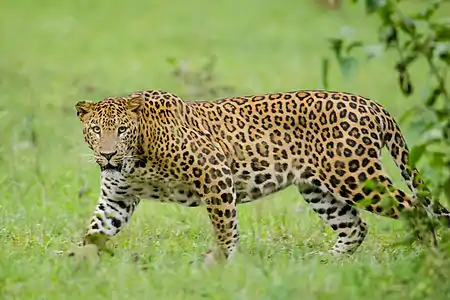 |
| Javan leopard (P. p. melas)[52] |
It is native to Java in Indonesia and is considered Critically Endangered.[2] | 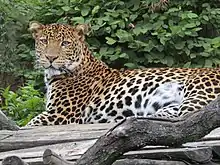 |
| Arabian leopard (P. p. nimr) [53] |
It is native to the Arabian Peninsula, but considered extinct in the Sinai Peninsula. It is the smallest leopard subspecies.[54] | 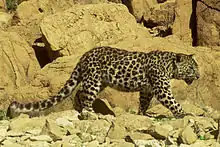 |
| Persian or Anatolian leopard (P. p. tulliana) [55][4] |
It persists in eastern Turkey, the Caucasus (Georgia, Armenia, southern European Russia, and Azerbaijan), Turkmenistan, Afghanistan, Iraq and northern Iran.[2]
The Balochistan leopard population possibly evolved in the south of Iran, Afghanistan and Pakistan, being separated from the northern population by the Dasht-e Kavir and Dasht-e Lut deserts.[56] |
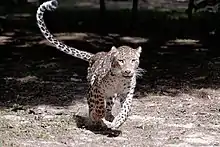 |
| Amur leopard (P. p. orientalis)[57][58] |
It is native to the Russian Far East and northern China, but is extirpated from the Korean peninsula.[2] | 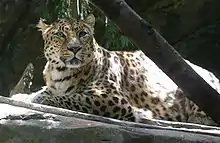 |
| Indochinese leopard (P. p. delacouri)[59] |
It is native to mainland Southeast Asia and southern China.[2] | 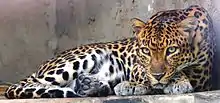 |
| Sri Lankan leopard (P. p. kotiya)[60] |
It is native to Sri Lanka.[2] | 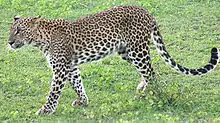 |
Results of an analysis of molecular variance and pairwise fixation index of 182 African leopard museum specimens published in 2017 showed that some African leopards exhibit higher genetic differences than certain Asian leopards which are recognized as subspecies.[61]
Evolution
Results of a phylogenetic analysis of chemical secretions amongst cats indicated that the leopard is closely related to the lion.[66]
Results of phylogenetic studies based on nDNA and mtDNA analysis showed that the last common ancestor of the Panthera and Neofelis genera is thought to have lived about 6.37 million years ago. Neofelis diverged about 8.66 million years ago from the Panthera lineage. The tiger diverged about 6.55 million years ago, followed by the snow leopard about 4.63 million years ago and the leopard about 4.35 million years ago. The leopard is a sister taxon to a clade within Panthera, consisting of the lion and the jaguar.[62][63] The geographic origin of the Panthera is most likely northern Central Asia. The leopard-lion clade was distributed in the Asian and African Palearctic since at least the early Pliocene.[67] The leopard-lion clade diverged 3.1–1.95 million years ago.[64][65] Additionally, a 2016 study revealed that the mitochondrial genomes of the leopard, lion and snow leopard are more similar to each other than their nuclear genomes, indicating that their ancestors hybridized with the snow leopard at some point in their evolution.[68]
Fossils of leopard ancestors were excavated in East Africa and South Asia, dating back to the Pleistocene between 2 and 3.5 million years ago. The modern leopard is suggested to have evolved in Africa about 0.5 to 0.8 million years ago and to have radiated across Asia about 0.2 and 0.3 million years ago.[49] Fossil cat teeth collected in Sumatra's Padang Highlands were assigned to the leopard. It has since been hypothesized that it became extirpated from the island due to the Toba eruption about 75,000 years ago,[69] and due to competition with other predators, such as the Sunda clouded leopard (Neofelis diardi) and the dhole (Cuon alpinus).[9]
In Europe, the leopard occurred at least since the Pleistocene. Leopard-like fossil bones and teeth possibly dating to the Pliocene were excavated in Perrier in France, northeast of London, and in Valdarno, Italy. Until 1940, similar fossils dating back to the Pleistocene were excavated mostly in loess and caves at 40 sites in Europe, including Furninha Cave near Lisbon, Genista Caves in Gibraltar, and Santander Province in northern Spain to several sites across France, Switzerland, Italy, Austria, Germany, in the north up to Derby in England, in the east to Přerov in the Czech Republic and the Baranya in southern Hungary,[70] Leopard fossils dating to the Late Pleistocene were found in Biśnik Cave in south-central Poland.[71] The oldest known leopard fossils excavated in Europe are about 600,000 years old and were found in the Grotte du Vallonnet in France and near Mauer in Germany.[1] Four European Pleistocene leopard subspecies were proposed. P. p. begoueni from the beginning of the Early Pleistocene was replaced about 0.6 million years ago by P. p. sickenbergi, which in turn was replaced by P. p. antiqua around 0.3 million years ago. The most recent, P. p. spelaea, appeared at the beginning of the Late Pleistocene and survived until about 24,000 years ago in several parts of Europe.[72] Leopard fossils dating to the Pleistocene were also excavated in the Japanese archipelago.[8]
Hybrids

The leopard was crossbred with other Panthera species in zoos. In 1953, a lioness and a male leopard were mated in Hanshin Park in Nishinomiya, Japan. The first litter from this pair was born in November 1959, consisting of a male and a female. Another litter was born in 1961, in which all the offspring were spotted and bigger than a juvenile leopard. This hybrid came to be known as a leopon. Unsuccessful attempts were made to mate a leopon with a tigress.[73]
Distribution and habitat
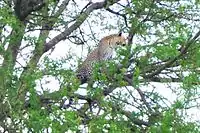

The leopard has the largest distribution of all wild cats, occurring widely in Africa as well as the Caucasus and Asia, although populations are fragmented and declining. It is considered to be extirpated in North Africa.[2] It inhabits foremost savanna and rainforest, and areas where grasslands, woodlands, and riverine forests remain largely undisturbed.[7] In sub-Saharan Africa, it is still numerous and surviving in marginal habitats where other large cats have disappeared. There is considerable potential for human-leopard conflict due to leopards preying on livestock.[75]
Leopard populations on the Arabian Peninsula are small and fragmented.[76][77][78] In southeastern Egypt, a leopard killed in 2017 was the first record in this area in 65 years.[79] In western and central Asia, it avoids deserts, areas with long snow cover and proximity to urban centres.[80]
In Nepal's Kanchenjunga Conservation Area, a melanistic leopard was photographed at an elevation of 4,300 m (14,100 ft) by a camera trap in May 2012.[81] In the Indian subcontinent, the leopard is still relatively abundant, with greater numbers than those of other Panthera species.[2] As of 2020, the leopard population within forested habitats in India's tiger range landscapes was estimated at 12,172 to 13,535 individuals. Surveyed landscapes included elevations below 2,600 m (8,500 ft) in the Shivalik Hills and Gangetic plains, Central India and Eastern Ghats, Western Ghats, as well as the Brahmaputra River basin and hills in Northeast India.[82] Some leopard populations in the country live quite close to human settlements and even in semi-developed areas. Although adaptable to human disturbances, leopards require healthy prey populations and appropriate vegetative cover for hunting for prolonged survival and thus rarely linger in heavily developed areas. Due to the leopard's stealth, people often remain unaware that they live in nearby areas.[83]
In Sri Lanka, leopards were recorded in Yala National Park and in unprotected forest patches, tea estates, grasslands, home gardens, pine and eucalyptus plantations.[84][85]
In Myanmar, leopards were recorded for the first time by camera traps in the hill forests of Myanmar's Karen State.[86] The Northern Tenasserim Forest Complex in southern Myanmar is considered a leopard stronghold. In Thailand, leopards are present in the Western Forest Complex, Kaeng Krachan-Kui Buri, Khlong Saeng-Khao Sok protected area complexes and in Hala Bala Wildlife Sanctuary bordering Malaysia. In Peninsular Malaysia, leopards are present in Belum-Temengor, Taman Negara and Endau-Rompin National Parks.[87] In Laos, leopards were recorded in Nam Et-Phou Louey National Biodiversity Conservation Area and Nam Kan National Protected Area.[88][89] In Cambodia, leopards inhabit deciduous dipterocarp forest in Phnom Prich Wildlife Sanctuary and Mondulkiri Protected Forest.[90][91] In southern China, leopards were recorded only in the Qinling Mountains during surveys in 11 nature reserves between 2002 and 2009.[92]
In Java, leopards inhabit dense tropical rainforests and dry deciduous forests at altitudes from sea level to 2,540 m (8,330 ft). Outside protected areas, leopards were recorded in mixed agricultural land, secondary forest and production forest between 2008 and 2014.[93]
In the Russian Far East, it inhabits temperate coniferous forests where winter temperatures reach a low of −25 °C (−13 °F).[49]
Behaviour and ecology
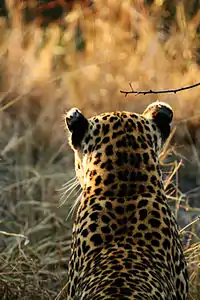
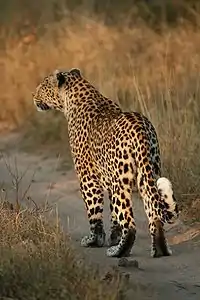
The leopard is a solitary and territorial animal. Adults associate only in the mating season. Females continue to interact with their offspring even after weaning, and have been observed sharing kills with their offspring when they can not obtain any prey. They produce a number of vocalizations, including growls, snarls, meows and purrs. The roaring sequence in leopards consists mainly of grunts and is also called "sawing", having been described as resembling the sound of sawing wood. Cubs are known to call their mother with a urr-urr sound.[24]
The whitish spots on the back of its ears are thought to play a role in communication.[94] It has been hypothesized that the white tips of their tails may function as a 'follow-me' signal in intraspecific communication. However, no significant association were found between a conspicuous colour of tail patches and behavioural variables in carnivores.[95][96]
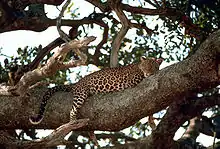
Leopards are active mainly from dusk till dawn and rest for most of the day and for some hours at night in thickets, among rocks or over tree branches. Leopards have been observed walking 1–25 km (1⁄2–15 1⁄2 mi) across their range at night; they may even wander up to 75 km (47 mi) if disturbed.[24][29] In some regions, they are nocturnal.[97][98] In western African forests, they have been observed to be largely diurnal and hunting during twilight, when their prey animals are active; activity patterns varies between seasons.[99]
Leopards can climb trees very skillfully, often rest on tree branches and descend from trees headfirst.[7] They can run at over 58 km/h (36 mph), leap over 6 m (20 ft) horizontally, and jump up to 3 m (10 ft) vertically.[100]
Social spacing
In Kruger National Park, most leopards tend to keep 1 km (1⁄2 mi) apart.[29] Males interact with their partners and cubs at times, and exceptionally this can extend beyond to two generations.[101][102] Aggressive encounters are rare, typically limited to defending territories from intruders.[23] In a South African reserve, a male was wounded in a male–male territorial battle over a carcass.[103]
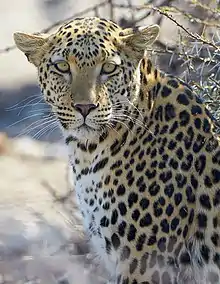
Males occupy territories that often overlap with a few smaller female territories, probably as a strategy to enhance access to females. In the Ivory Coast, the home range of a female was completely enclosed within a male's.[104] Females live with their cubs in territories that overlap extensively, probably due to the association between mothers and their offspring. There may be a few other fluctuating territories, belonging to young individuals. It is not clear if male territories overlap as much as those of females do. Individuals try to drive away intruders of the same sex.[24][29]
A study of leopards in the Namibian farmlands showed that the size of territories was not significantly affected by sex, rainfall patterns or season; it concluded that the higher the prey availability in an area, the greater the population density of leopards and the smaller the size of territories, but territories tend to expand if there is human interference (which has been notably high in the study area).[105] Territorial sizes vary geographically and depending on habitat and availability of prey. In the Serengeti, they are as small as 33–38 km2 (12 1⁄2–14 1⁄2 sq mi) for males and 14–16 km2 (5 1⁄2–6 sq mi) for females,[106][107] and as large as 451 km2 (174 sq mi) for males and 188 km2 (72 1⁄2 sq mi) for females in northeastern Namibia.[108] They are even larger in arid and montane areas.[23] Territories recorded in Nepal's Bardia National Park, 48 km2 (18 1⁄2 sq mi) for males and 5–7 km2 (2–2 1⁄2 sq mi) for females, are smaller than those generally observed in Africa.[109]
Hunting and diet
_stalking.jpg.webp)
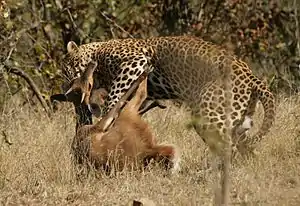
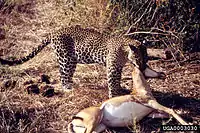
_devorando_un_ant%C3%ADlope%252C_parque_nacional_Kruger%252C_Sud%C3%A1frica%252C_2018-07-26%252C_DD_06.jpg.webp)
The leopard depends mainly on its acute senses of hearing and vision for hunting.[110] It primarily hunts at night in most areas.[24] In western African forests and Tsavo National Park, leopards have been also observed hunting by day.[111] Leopards usually hunt on the ground. In the Serengeti, leopards have been observed to ambush prey by jumping down on it from trees.[112]
The leopard is a carnivore that prefers medium-sized prey with a body mass ranging from 10–40 kg (22–88 lb). Prey species in this weight range tend to occur in dense habitat and to form small herds. Species that prefer open areas and developed significant anti-predator strategies are less preferred. More than 100 prey species were recorded. The most significantly preferred species are ungulates; impala, bushbuck, common duiker and chital. Primate species preyed upon include those of the genera Cercocebus, Cercopithecus and Semnopithecus.[113] Analysis of leopard scat in Taï National Park revealed that primates, except for chimpanzee and potto, are primary leopard prey during the day.[114] Leopards also kill smaller carnivores like black-backed jackal, bat-eared fox, genet and cheetah.[113]
Prey as heavy as a 550 kg (1,210 lb) giraffe is hunted, especially in areas that lack larger carnivores such as lions or tigers since they do not need to drag prey up trees to retain it. In areas such as Sri Lanka, reserves in Central Asia and the Middle East and most of the montane and tropical rainforests of Africa, the leopard is the remaining top terrestrial predator present and often take varied prey of various sizes, including at times large ungulates weighing hundreds of kilograms, although they also takes smaller prey such as monkeys where ungulates are scarce.[115] A study in Wolong National Nature Reserve in southern China demonstrated variation in the leopard's diet over time; over the course of seven years, the vegetative cover receded, and leopards opportunistically shifted from primarily consuming tufted deer to pursuing bamboo rats and other smaller prey.[116] The largest prey killed by a leopard was reportedly a male eland weighing 900 kg (2,000 lb).[100]
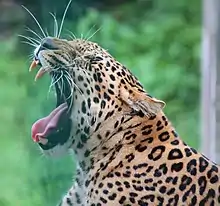
Average daily consumption rates of 3.5 kg (7 lb 11 oz) were estimated for males and of 2.8 kg (6 lb 3 oz) for females.[117] A study in the southern Kalahari Desert showed that leopards meet their water requirements by the bodily fluids of prey and succulent plants; they drink water every two to three days, and feed infrequently on moisture-rich plants such as gemsbok cucumbers (Acanthosicyos naudinianus), tsamma melon (Citrullus lanatus) and Kalahari sour grass (Schmidtia kalahariensis).[118]
The leopard stalks its prey and tries to approach as close as possible, typically within 5 m (16 ft) to the target, and finally pounces on it and kills it by suffocation. It kills small prey with a bite on the back of the neck, but holds larger animals by the throat and strangles them.[24] It is able to take large prey due to its massive skull and powerful jaw muscles, and is therefore strong enough to drag carcasses heavier than itself up into trees; an individual was seen to haul a young giraffe, weighing nearly 125 kg (276 lb), up 5.7 m (18 ft 8 in) into a tree.[111] Kills are cached up to 2 km (1 1⁄4 mi) apart.[101] Small prey is eaten immediately, while larger carcasses are dragged over several hundred metres and safely cached in trees, bushes or even caves to be consumed later. The way the kill is stored depends on local topography and individual preferences; while trees are preferred in Kruger National Park, bushes are preferred in the plain terrain of the Kalahari.[23][119]
Enemies and competitors
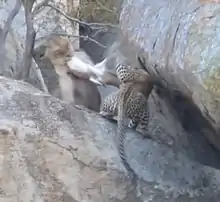
In parts of its global range, the leopard is sympatric with other large predators such as tiger, lion, cheetah, spotted hyena, striped hyena, brown hyena, African wild dog, dhole and up to five bear species. Some of these species steal its kills, kill its cubs and even kill adult leopards. Leopards retreat up a tree in the face of direct aggression, and were observed when killing or preying on smaller competitors such as black-backed jackal, African civet, caracal, and African wildcat.[7][120] Leopards generally seem to avoid encounters with adult bears, but kill vulnerable bear cubs. In Sri Lanka, a few recorded vicious fights between leopards and sloth bears apparently result in both animals winding up either dead or grievously injured.[121][122]
While interspecies killing of full-grown leopards is generally rare, given the opportunity, both tiger and lion readily kill and consume both young and adult leopards.[112][120][123][124] In the Kalahari Desert, leopards frequently lose kills to brown hyenas, if the leopard is unable to move the kill into a tree. Single brown hyenas have been observed charging at and displacing male leopards from kills.[125][126] Lions occasionally fetch leopard kills from trees.[119]
Resource partitioning occurs where leopards share their range with tigers. Leopards tend to take smaller prey, usually less than 75 kg (165 lb), where tigers are present.[7] In areas where leopard and tiger are sympatric, coexistence is reportedly not the general rule, with leopards being few where tigers are numerous.[123] The mean leopard density decreased significantly (from 9.76 to 2.07 animals per 100 km2 (39 sq mi)) while the mean density of tigers increased (from 3.31 to 5.81 animals/100 km2) from 2004–2005 to 2008 in Rajaji National Park following the relocation of pastoralists out of the park. There, the two species have high dietary overlap, and an increase in the tiger population resulted in a sharp decrease in the leopard population and a shift in the leopard diet to small prey (from 9% to 36%) and domestic prey (from 6.8% to 31.8%).[127] In Chitwan National Park, leopards killed prey ranging from less than 25–100 kg (55–220 lb) in weight with most kills in the 25–50 kg (55–110 lb) range. Tigers killed more prey in the 50–100 kg (110–220 lb) range. There were also differences in the microhabitat preferences of the individual tiger and leopard followed over five months; the tiger used roads and forested areas more frequently, while the leopard used recently burned areas and open areas more frequently. When a tiger killed baits at sites formerly frequented by leopards, the leopards did not hunt there for some time.[123] In the tropical forests of India's Nagarhole National Park, tigers selected prey weighing more than 176 kg (388 lb), whereas leopards selected prey in the 30–175 kg (66–386 lb) range.[128] In tropical forests, they do not always avoid the larger cats by hunting at different times. With relatively abundant prey and differences in the size of prey selected, tigers and leopards seem to successfully coexist without competitive exclusion or interspecies dominance hierarchies that may be more common to the leopard's co-existence with the lion in savanna habitats.[129] In areas with high tiger populations, such as in the central parts of India's Kanha National Park, leopards are not permanent residents, but transients. They were common near villages at the periphery of the park and outside the park.[123] In a reserved forest of southern India, species preyed upon by leopard, dhole and striped hyena overlapped considerably.[130] In the mid-20th century, Amur leopards were absent or very rarely encountered in the Primorye region of the Russian Far East at places where Siberian tigers roamed.[26] Surveys conducted at the beginning of the 21st century revealed that the ranges of both species overlap in this region, especially in protected areas where ungulate densities are high and human disturbance is low.[131] Two cases of leopards killing cheetahs have been reported in 2014.[132][133]
Nile crocodiles prey on leopards occasionally. One large adult leopard was grabbed and consumed by a large crocodile while attempting to hunt along a bank in Kruger National Park.[117][101] Mugger crocodiles reportedly killed an adult leopard in Rajasthan.[134] An adult leopard was recovered from the stomach of a 5.5 m (18 ft 1 in) Burmese python.[135]
In Serengeti National Park, troops of 30–40 olive baboons were observed while mobbing and attacking a female leopard and her cubs.[136]
Reproduction and life cycle
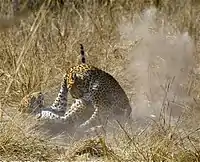
.jpg.webp)
Depending on the region, leopards may mate all year round. In Manchuria and Siberia, they mate during January and February. The estrous cycle lasts about 46 days and the female usually is in heat for 6–7 days.[137] Gestation lasts for 90 to 105 days.[138] Cubs are usually born in a litter of 2–4 cubs.[139] Mortality of cubs is estimated at 41–50% during the first year.[117]
Females give birth in a cave, crevice among boulders, hollow tree, or thicket to make a den. Cubs are born with closed eyes, which open four to nine days after birth.[100] The fur of the young tends to be longer and thicker than that of adults. Their pelage is also more gray in colour with less defined spots. Around three months of age, the young begin to follow the mother on hunts. At one year of age, leopard young can probably fend for themselves, but remain with the mother for 18–24 months.[140]
The average typical life span of a leopard is between 12 and 17 years.[141] The oldest recorded spotted leopard was a female named Roxanne living in captivity at McCarthy's Wildlife Sanctuary in The Acreage, Palm Beach County, Florida. She died August 8, 2014 at the age of 24 years, 2 months and 13 days. This has been verified by the Guinness Book of World Records.[142] Previously, the oldest recorded leopard was a female named Bertie living in captivity in the Warsaw Zoo. She died in December 2010 at the age of 24.[143] The oldest recorded male leopard was Cezar, who reached the age of 23. He also lived at the Warsaw Zoo and was Bertie's lifelong companion.[144] The generation length of the leopard is 9.3 years.[145]
Threats
The leopard is primarily threatened by habitat fragmentation and conversion of forest to agriculturally used land, which lead to a declining natural prey base, human–wildlife conflict with livestock herders and high leopard mortality rates. It is also threatened by trophy hunting and poaching.[2]
Between 2002 and 2012, at least four leopards were estimated to have been poached per week in India for the illegal wildlife trade of its skins and bones.[146] In spring 2013, 37 leopard skins were found during a 7-week long market survey in major Moroccan cities.[147] In 2014, 43 leopard skins were detected during two surveys in Morocco. Vendors admitted to have imported skins from sub-Saharan Africa.[148]
Surveys in the Central African Republic's Chinko area revealed that the leopard population decreased from 97 individuals in 2012 to 50 individuals in 2017. In this period, transhumant pastoralists from the border area with Sudan moved in the area with their livestock. Rangers confiscated large amounts of poison in the camps of livestock herders who were accompanied by armed merchants. They engaged in poaching large herbivores, sale of bushmeat and trading leopard skins in Am Dafok.[149]
Leopards and humans

Leopards have been known to humans throughout history, and have featured in the art, mythology, and folklore of many countries where they have historically occurred. In Greek mythology, the leopard was a symbol of the god Dionysus; who was depicted wearing leopard skin and using leopards as means of transportation. In one myth, the god was captured by pirates but two leopards appear and rescue him. The Ancient Romans kept leopards in captivity to be slaughtered in hunts as well as be used in executions of criminals.[150] During the Benin Empire, the leopard was commonly represented on engravings and sculptures and was used to symbolize the power of the king or oba, since the leopard was considered the king of the forest. Leopards were also kept and paraded as mascots, totems and sacrifices to deities.[151]

The lion passant guardant or leopard is a frequently used charge in heraldry, most commonly appearing in groups of three.[152] The heraldic leopard lacks spots and sports a mane, making it visually almost identical to the heraldic lion, and the two are often used interchangeably. These traditional lions passant guardant appear in the coat of arms of Dalmatia and the coat of arms of England and many of its former colonies; more modern naturalistic (leopard-like) depictions appear on the coat of arms of several African nations including Benin, Malawi, Somalia, the Democratic Republic of the Congo and Gabon, the last of which uses a black panther.[153] The coat of the leopard has been popular decorative clothing and a symbol of power, wealth and the exotic, being worn by African chiefs, European queens, Hollywood film stars and burlesque dancers.[150]
Leopard captivity in historical times has also been recorded — several leopards were kept in a menagerie established by King John at the Tower of London in the 13th century; around 1235, three of these animals were given to Henry III by Holy Roman Emperor Frederick II.[154]
Tourism
In protected areas of several countries, wildlife touring programs and safari ventures offer sightings of leopards in their natural habitat. While luxury establishments may boast the fact that wild animals can be seen at close range on a daily basis, the leopard's camouflage and propensity to hide and stalk prey typically make leopard sightings rare.[155] In Sri Lanka's Yala National Park, leopards have been ranked by visitors to be among the least visible of all animals in the park, despite their high concentration in the reserve.[156]
In South Africa, safaris are offered in numerous nature reserves such as in Sabi Sand Game Reserve. In Sri Lanka, wildlife tours are available in Yala and Wilpattu National Parks. In India, safaris are offered in Madhya Pradesh and Uttarakhand national parks as well as in the Pali district of western Rajasthan.[157]
Man-eating
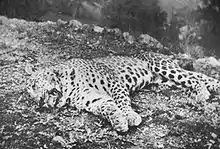
Most leopards avoid people, but humans may occasionally be targeted as prey. Most healthy leopards prefer wild prey to humans, but injured, sickly, or struggling cats or those with a shortage of regular prey may resort to hunting humans and become habituated to it. Although usually slightly smaller than a human, an adult leopard is much more powerful and easily capable of killing one. Two extreme cases occurred in India: the first leopard, "the Leopard of Rudraprayag", killed more than 125 people; the second, "the Panar Leopard", was believed to have killed more than 400. Both were killed by the renowned hunter and conservationist Jim Corbett.[158] Man-eating leopards are considered bold and difficult to track and may enter human settlements for prey, more so than lions and tigers.[159] Author and big game hunter, Kenneth Anderson, had first-hand experience with many man-eating leopards, and described them as far more threatening than tigers:
Although examples of such animals are comparatively rare, when they do occur they depict the panther [leopard] as an engine of destruction quite equal to his far larger cousin, the tiger. Because of his smaller size he can conceal himself in places impossible to a tiger, his need for water is far less, and in veritable demoniac cunning and daring, coupled with the uncanny sense of self-preservation and stealthy disappearance when danger threatens, he has no equal.
— Kenneth Anderson, Nine Man-Eaters and One Rogue, Chapter II "The Spotted Devil of Gummalapur"
There is something very terrifying in the angry grunt of a charging leopard, and I have seen a line of elephants that were staunch to a tiger, turn and stampede from a charging leopard.
— Jim Corbett, The Temple Tiger and More Man-Eaters of Kumaon, chapter "The Panar Man-Eater"
See also
References
- Ghezzo, E.; Rook, L. (2015). "The remarkable Panthera pardus (Felidae, Mammalia) record from Equi (Massa, Italy): taphonomy, morphology, and paleoecology". Quaternary Science Reviews. 110 (110): 131–151. doi:10.1016/j.quascirev.2014.12.020.
- Stein, A.B.; Athreya, V.; Gerngross, P.; Balme, G.; Henschel, P.; Karanth, U.; Miquelle, D.; Rostro-Garcia, S.; Kamler, J. F.; Laguardia, A.; Khorozyan, I. & Ghoddousi, A. (2020). "Panthera pardus". IUCN Red List of Threatened Species. 2020: e.T15954A163991139.
- Wozencraft, W.C. (2005). "Species Panthera pardus". In Wilson, D.E.; Reeder, D.M (eds.). Mammal Species of the World: A Taxonomic and Geographic Reference (3rd ed.). Johns Hopkins University Press. p. 547. ISBN 978-0-8018-8221-0. OCLC 62265494.
- Kitchener, A. C.; Breitenmoser-Würsten, C.; Eizirik, E.; Gentry, A.; Werdelin, L.; Wilting, A.; Yamaguchi, N.; Abramov, A. V.; Christiansen, P.; Driscoll, C.; Duckworth, J. W.; Johnson, W.; Luo, S.-J.; Meijaard, E.; O’Donoghue, P.; Sanderson, J.; Seymour, K.; Bruford, M.; Groves, C.; Hoffmann, M.; Nowell, K.; Timmons, Z.; Tobe, S. (2017). "A revised taxonomy of the Felidae: The final report of the Cat Classification Task Force of the IUCN Cat Specialist Group" (PDF). Cat News (Special Issue 11): 73–75.
- Jacobson, A. P.; Gerngross, P.; Lemeris Jr., J. R.; Schoonover, R. F.; Anco, C.; Breitenmoser-Würsten, C.; Durant, S. M.; Farhadinia, M. S.; Henschel, P.; Kamler, J. F.; Laguardia, A.; Rostro-García, S.; Stein, A. B.; Dollar, L. (2016). "Leopard (Panthera pardus) status, distribution, and the research efforts across its range". PeerJ. 4: e1974. doi:10.7717/peerj.1974. PMC 4861552. PMID 27168983.
- Williams, S. T.; Williams, K. S.; Lewis, B. P.; Hill, R. A. (2017). "Population dynamics and threats to an apex predator outside protected areas: implications for carnivore management". Royal Society Open Science. 4 (4): 161090. Bibcode:2017RSOS....461090W. doi:10.1098/rsos.161090. PMC 5414262. PMID 28484625.
- Nowell, K. & Jackson, P. (1996). "Leopard Panthera pardus (Linnaeus, 1758)". Wild Cats: status survey and conservation action plan. Gland, Switzerland: IUCN/SSC Cat Specialist Group. Archived from the original on 2014-02-22.
- Izawa, M.; Nakanishi, N. (2015). "Felidae". In Ohdachi, S. D.; Ishibashi, Y.; Iwasa, M. A.; Saitoh, T. (eds.). The Wild Mammals of Japan (Second ed.). Kyoto: Shoukadoh Book Sellers and the Mammalogical Society of Japan. pp. 226−231. ISBN 978-4-87974-691-7.
- Volmer, R.; Hölzchen, E.; Wurster, A.; Ferreras, M.R. & Hertler, C. (2017). "Did Panthera pardus (Linnaeus, 1758) become extinct in Sumatra because of competition for prey? Modeling interspecific competition within the Late Pleistocene carnivore guild of the Padang Highlands, Sumatra". Palaeogeography, Palaeoclimatology, Palaeoecology. 487: 175–186. doi:10.1016/j.palaeo.2017.08.032.
- Lewis, C. T. & Short, C. (1879). "lěǒpardus". A Latin Dictionary. Oxford: Clarendon Press. p. 1069.
- Liddell, H. G. & Scott, R. (1889). "λέο-πάρδος". A Greek–English Lexicon. Oxford: Clarendon Press. p. 884.
- Partridge, E. (1983). Origins: A Short Etymological Dictionary of Modern English. New York: Greenwich House. p. 349. ISBN 978-0-517-41425-5.
- Nicholas, N. (1999). "A conundrum of cats: pards and their relatives in Byzantium". Greek, Roman, and Byzantine Studies. 40: 253–298. S2CID 56160515.
- Lewis, C. T. & Short, C. (1879). "panthera". A Latin Dictionary. Oxford: Clarendon Press. p. 1298.
- Macdonell, A. A. (1929). "पाण्डर pând-ara". A Practical Sanskrit Dictionary with Transliteration, Accentuation, and Etymological Analysis throughout. London: Oxford University Press. p. 95.
- Lewis, C. T. & Short, C. (1879). "pardus". A Latin Dictionary. Oxford: Clarendon Press. p. 1302.
- Liddell, H. G. & Scott, R. (1889). "παρδάλωτός". A Greek–English Lexicon. Oxford: Clarendon Press. p. 1148.
- Mills, M. G. L. (2005). "Subfamily Pantherinae". In Skinner, J. D.; Chimimba, C. T. (eds.). The mammals of the southern African subregion (Third ed.). Cambridge: Cambridge University Press. pp. 385–396. ISBN 9780521844185.
- Mivart, St. G. J. (1900). "Different kind of Cats". The Cat: An Introduction to the Study of Backboned Animals, Especially Mammals. London: John Murray. pp. 391–439.
- Pocook, R. I. (1932). "The Leopards of Africa". Proceedings of the Zoological Society of London. 102 (2): 543–591. doi:10.1111/j.1096-3642.1932.tb01085.x.
- Schütze, H. (2002). Field Guide to the Mammals of the Kruger National Park. Cape Town, South Africa: Struik Publishers. pp. 92–93. ISBN 978-1-86872-594-6.
- Menon, V. (2014). Indian Mammals: A Field Guide. Gurgaon, India: Hachette. ISBN 978-93-5009-761-8.
- Stein, A. B.; Hayssen, V. (2010). "Panthera pardus (Carnivora: Felidae)" (PDF). Mammalian Species. 45 (900): 30–48. doi:10.1644/900.1. S2CID 44839740. Archived from the original (PDF) on 2016-03-05.
- Estes, R. (1991). "Leopard Panthera pardus". The Behavior Guide to African Mammals, Including Hoofed Mammals, Carnivores, Primates. Los Angeles: The University of California Press. pp. 366–369. ISBN 978-0-520-08085-0.
- Hoath, R. (2009). "Leopard Panthera pardus (Linnaeus, 1758)". Field Guide to the Mammals of Egypt. Cairo, Egypt: American University in Cairo Press. pp. 106–107. ISBN 978-977-416-254-1.
- Heptner, V. G.; Sludskii, A. A. (1992) [1972]. "Bars (leopard)". Mlekopitajuščie Sovetskogo Soiuza. Moskva: Vysšaia Škola [Mammals of the Soviet Union, Volume II, Part 2]. Washington DC: Smithsonian Institution and the National Science Foundation. pp. 203–273. ISBN 978-90-04-08876-4.
- Tanomtong, A.; Khunsook, S.; Keawmad, P.; Pintong, K. (2008). "Cytogenetic study of the leopard, Panthera pardus (Carnivora, Felidae) by conventional staining, G-banding and high-resolution staining technique". Cytologia. 73 (1): 81–90. doi:10.1508/cytologia.73.81.
- Prater, S. H. (1921). "Record Panther Skull (P. p. pardus)". The Journal of the Bombay Natural History Society. XXVII (Part IV): 933–935.
- Nowak, R. M. (1999). "Panthera pardus (Leopard)". Walker's Mammals of the World (Sixth ed.). Baltimore, USA: Johns Hopkins University Press. pp. 828–831. ISBN 978-0-8018-5789-8.
- Pease, A. E. (1913). "Of dangerous game". The Book of the Lion. London: John Murray. pp. 46–68.
- Burnie, D. & Wilson, D. E., eds. (2001). Animal: The Definitive Visual Guide to the World's Wildlife. DK Adult. ISBN 978-0-7894-7764-4.
- "Is this the longest leopard in India?". The Times of India. 2016.
- "Leopard shot in Bilaspur turns out to be a record breaker". The Tribune Trust. 2016.
- Eizirik, E.; Yuhki, N.; Johnson, W. E.; Menotti-Raymond, M.; Hannah, S. S.; O'Brien, S. J. (2003). "Molecular genetics and evolution of melanism in the cat family" (PDF). Current Biology. 13 (5): 448–453. doi:10.1016/S0960-9822(03)00128-3. PMID 12620197. S2CID 19021807. Archived from the original (PDF) on 2013-05-06.
- Robinson, R. (1970). "Inheritance of the black form of the leopard Panthera pardus". Genetica. 41 (1): 190–197. doi:10.1007/BF00958904. PMID 5480762. S2CID 5446868.
- da Silva L. G., K.; Kawanishi, K.; Henschel P.; Kittle, A.; Sanei, A.; Reebin, A.; Miquelle, D.; Stein, A. B.; Watson, A.; Kekule, L. B.; Machado, R. B. & Eizirik, E. (2017). "Mapping black panthers: Macroecological modeling of melanism in leopards (Panthera pardus)". PLOS ONE. 12 (4): e0170378. Bibcode:2017PLoSO..1270378D. doi:10.1371/journal.pone.0170378. PMC 5381760. PMID 28379961.
- Kawanishi, K.; Sunquist, M. E.; Eizirik, E.; Lynam, A. J.; Ngoprasert, D.; Wan Shahruddin, W. N.; Rayan, D. M.; Sharma, D. S. K.; Steinmetz, R. (2010). "Near fixation of melanism in leopards of the Malay Peninsula". Journal of Zoology. 282 (3): 201–206. doi:10.1111/j.1469-7998.2010.00731.x.
- Sunquist, F. (2007). "Malaysian Mystery Leopards". National Wildlife Magazine. 45 (1). Archived from the original on 2008-01-16.
- Shuker, K. P. N. (2003). The Beasts that Hide from Man : Seeking the World's Last Undiscovered Animals. New York, USA: Paraview Press. p. 273. ISBN 978-1-931044-64-6.
- Divyabhanusinh (1993). "On mutant leopards Panthera pardus from India". Journal of the Bombay Natural History Society. 90 (1): 88−89.
- Pirie, T. J.; Thomas, R. L.; Fellowes, M. D. E. (2016). "Erythristic leopards Panthera pardus in South Africa". Bothalia. 46 (1): 1–5. doi:10.4102/abc.v46i1.2034.
- Linnaeus, C. (1758). "Felis pardus". Caroli Linnæi Systema naturæ per regna tria naturæ, secundum classes, ordines, genera, species, cum characteribus, differentiis, synonymis, locis. Tomus I (decima, reformata ed.). Holmiae: Laurentius Salvius. p. 41−42. (in Latin)
- Oken, L. (1816). "1. Art, Panthera". Lehrbuch der Zoologie. 2. Abtheilung. Jena: August Schmid & Comp. p. 1052.
- Ellerman, J. R.; Morrison-Scott, T. C. S. (1966). Checklist of Palaearctic and Indian mammals 1758 to 1946 (Second ed.). London: British Museum of Natural History. pp. 315–317.
- Allen, J. A. (1902). "Mammal names proposed by Oken in his 'Lehrbuch der Zoologie'" (PDF). Bulletin of the American Museum of Natural History. 16 (27): 373−379.
- Pocock, R. I. (1917). "The Classification of existing Felidae". The Annals and Magazine of Natural History. Series 8. XX: 329–350. doi:10.1080/00222931709487018.
- Pocock, R. I. (1939). "Panthera pardus". The Fauna of British India, including Ceylon and Burma. Mammalia: Volume 1. London: Taylor and Francis. pp. 222–239.
- Miththapala, S.; Seidensticker, J.; O'Brien, S. J. (1996). "Phylogeographic subspecies recognition in leopards (Panthera pardus): molecular genetic variation" (PDF). Conservation Biology. 10 (4): 1115–1132. doi:10.1046/j.1523-1739.1996.10041115.x.
- Uphyrkina, O.; Johnson, E. W.; Quigley, H.; Miquelle, D.; Marker, L.; Bush, M.; O'Brien, S. J. (2001). "Phylogenetics, genome diversity and origin of modern leopard, Panthera pardus" (PDF). Molecular Ecology. 10 (11): 2617–2633. doi:10.1046/j.0962-1083.2001.01350.x. PMID 11883877.
- Meyer, F. A. A. (1794). "Über de la Metheries schwarzen Panther". Zoologische Annalen. Erster Band. Weimar: Im Verlage des Industrie-Comptoirs. pp. 394–396.
- Laguardia, A.; Kamler, J. F.; Li, S.; Zhang, C.; Zhou, Z.; Shi, K. (2017). "The current distribution and status of leopards Panthera pardus in China". Oryx. 51 (1): 153−159. doi:10.1017/S0030605315000988.
- Cuvier, G. (1809). "Recherches sur les espėces vivantes de grands chats, pour servir de preuves et d'éclaircissement au chapitre sur les carnassiers fossils". Annales du Muséum National d'Histoire Naturelle. Tome XIV: 136–164.
- Hemprich, W.; Ehrenberg, C. G. (1830). "Felis, pardus?, nimr". In Dr. C. G. Ehrenberg (ed.). Symbolae Physicae, seu Icones et Descriptiones Mammalium quae ex Itinere per Africam Borealem et Asiam Occidentalem Friderici Guilelmi Hemprich et Christiani Godofredi Ehrenberg. Decas Secunda. Zoologica I. Mammalia II. Berolini: Officina Academica. pp. Plate 17.
- Spalton, J. A.; Al Hikmani, H. M. (2006). "The Leopard in the Arabian Peninsula – Distribution and Subspecies Status" (PDF). Cat News (Special Issue 1): 4–8.
- Valenciennes, A. (1856). "Sur une nouvelles espèce de Panthère tué par M. Tchihatcheff à Ninfi, village situé à huit lieues est de Smyrne". Comptes Rendus Hebdomadaires des Séances de l'Académie des Sciences. 42: 1035–1039.
- Khorozyan, I. G.; Gennady, F.; Baryshnikov, G. F.; Abramov, A. V. (2006). "Taxonomic status of the leopard, Panthera pardus (Carnivora, Felidae) in the Caucasus and adjacent areas" (PDF). Russian Journal of Theriology. 5 (1): 41–52. doi:10.15298/rusjtheriol.05.1.06. Archived from the original (PDF) on 2016-03-03.
- Schlegel, H. (1857). "Felis orientalis". Handleiding Tot de Beoefening der Dierkunde, Ie Deel. Breda: Boekdrukkerij van Nys. p. 23.
- Gray, J. E. (1862). "Description of some new species of Mammalia". Proceedings of the Royal Zoological Society of London. 30: 261−263, plate XXXIII. doi:10.1111/j.1469-7998.1862.tb06524.x.
- Pocock, R. I. (1930). "The Panthers and Ounces of Asia". Journal of the Bombay Natural History Society. 34 (2): 307–336.
- Deraniyagala, P. E. P. (1956). "The Ceylon leopard, a distinct subspecies". Spolia Zeylanica. 28: 115–116.
- Anco, C.; Kolokotronis, S. O.; Henschel, P.; Cunningham, S. W.; Amato, G.; Hekkala, E. (2017). "Historical mitochondrial diversity in African leopards (Panthera pardus) revealed by archival museum specimens". Mitochondrial DNA Part A. 29 (3): 455–473. doi:10.1080/24701394.2017.1307973. PMID 28423965. S2CID 4348541.
- Johnson, W. E.; Eizirik, E.; Pecon-Slattery, J.; Murphy, W. J.; Antunes, A.; Teeling, E.; O'Brien, S. J. (2006). "The late Miocene radiation of modern Felidae: a genetic assessment". Science. 311 (5757): 73–77. Bibcode:2006Sci...311...73J. doi:10.1126/science.1122277. PMID 16400146. S2CID 41672825.
- Werdelin, L.; Yamaguchi, N.; Johnson, W. E.; O'Brien, S. J. (2010). "Phylogeny and evolution of cats (Felidae)". In Macdonald, D. W.; Loveridge, A. J. (eds.). Biology and Conservation of Wild Felids. Oxford, UK: Oxford University Press. pp. 59–82. ISBN 978-0-19-923445-5.
- Davis, B. W.; Li, G.; Murphy, W. J. (2010). "Supermatrix and species tree methods resolve phylogenetic relationships within the big cats, Panthera (Carnivora: Felidae)" (PDF). Molecular Phylogenetics and Evolution. 56 (1): 64–76. doi:10.1016/j.ympev.2010.01.036. PMID 20138224. Archived from the original (PDF) on 2016-03-05.
- Mazák, J. H.; Christiansen, P.; Kitchener, A. C.; Goswami, A. (2011). "Oldest known pantherine skull and evolution of the tiger". PLOS ONE. 6 (10): e25483. Bibcode:2011PLoSO...625483M. doi:10.1371/journal.pone.0025483. PMC 3189913. PMID 22016768.
- Bininda-Emonds, O. R. P.; Decker-Flum, D. M.; Gittleman, J. L. (2001). "The utility of chemical signals as phylogenetic characters: an example from the Felidae" (PDF). Biological Journal of the Linnean Society. 72 (1): 1–15. doi:10.1111/j.1095-8312.2001.tb01297.x. Archived from the original (PDF) on 2010-01-31. Retrieved 2008-06-07.
- Tseng, Z. J.; Wang, X.; Slater, G. J.; Takeuchi, G. T.; Li, Q.; Liu, J.; Xie, G. (2014). "Himalayan fossils of the oldest known pantherine establish ancient origin of big cats". Proceedings of the Royal Society B: Biological Sciences. 281 (1774): 20132686. doi:10.1098/rspb.2013.2686. PMC 3843846. PMID 24225466.
- Li, G.; Davis, B. W.; Eizirik, E.; Murphy, W. J. (2016). "Phylogenomic evidence for ancient hybridization in the genomes of living cats (Felidae)". Genome Research. 26 (1): 1–11. doi:10.1101/gr.186668.114. PMC 4691742. PMID 26518481.
- Wilting, A.; Patel, R.; Pfestorf, H.; Kern, C.; Sultan, K.; Ario, A.; Peñaloza, F.; Kramer‐Schadt, S.; Radchuk, V.; Foerster, D.W. & Fickel, J. (2016). "Evolutionary history and conservation significance of the Javan leopard Panthera pardus melas". Journal of Zoology. 299 (4): 239–250.
- Schmid, E. (1940). "Variationstatistische Untersuchungen am Gebiss pleistozäner und rezenter Leoparden und anderer Feliden". Zeitschrift für Säugetierkunde. 15: 1–179.
- Marciszak, A.; Stefaniak, K. (2010). "Two forms of cave lion: Middle Pleistocene Panthera spelaea fossilis Reichenau, 1906 and Upper Pleistocene Panthera spelaea spelaea Goldfuss, 1810 from the Bísnik Cave, Poland". Neues Jahrbuch für Geologie und Paläontologie - Abhandlungen. 258 (3): 339–351. doi:10.1127/0077-7749/2010/0117.
- Diedrich, C. G. (2013). "Late Pleistocene leopards across Europe – northernmost European German population, highest elevated records in the Swiss Alps, complete skeletons in the Bosnia Herzegowina Dinarids and comparison to the Ice Age cave art". Quaternary Science Reviews. 76: 167–193. Bibcode:2013QSRv...76..167D. doi:10.1016/j.quascirev.2013.05.009.
- Kisling, V.N., ed. (2001). Zoo and Aquarium History : Ancient Animal Collections to Zoological Gardens. Boca Raton, Florida (USA): CRC Press. p. 314. ISBN 978-0-8493-2100-9.
- Murphey, R. (1951). "The Decline of North Africa Since the Roman Occupation: Climatic or Human?" (PDF). Annals of the Association of American Geographers. XLI (2): 116–132. doi:10.1080/00045605109352048.
- Pirie, T. J.; Thomas, R. L.; Fellowes, M. D. E. (2017). "Increasing game prices may alter farmers' behaviours towards leopards (Panthera pardus) and other carnivores in South Africa". PeerJ. 5: e3369. doi:10.7717/peerj.3369. PMC 5452990. PMID 28584709.
- Spalton, J. A.; Al Hikmani, H. M. (2006). "The Leopard in the Arabian Peninsula – Distribution and Subspecies Status" (PDF). Cat News (Special Issue 1): 4–8.
- Judas, J.; Paillat, P.; Khoja, A.; Boug, A. (2006). "Status of the Arabian leopard in Saudi Arabia" (PDF). Cat News (Special Issue 1): 11–19.
- Al Jumaily, M.; Mallon, D. P.; Nasher, A. K.; Thowabeh, N. (2006). "Status Report on Arabian Leopard in Yemen". Cat News (Special Issue 1): 20–25.
- Soultan, A.; Attum, O.; Hamada, A.; Hatab, E. B.; Ahmed, S. E.; Eisa, A.; Al Sharif, I.; Nagy, A. and Shohdi, W. (2017). "Recent observation for leopard Panthera pardus in Egypt". Mammalia. 81 (1): 115–117. doi:10.1515/mammalia-2015-0089. S2CID 90676105.CS1 maint: multiple names: authors list (link)
- Gavashelishvili, A.; Lukarevskiy, V. (2008). "Modelling the habitat requirements of leopard Panthera pardus in west and central Asia". Journal of Applied Ecology. 45 (2): 579–588. doi:10.1111/j.1365-2664.2007.01432.x.
- Thapa, K.; Pradhan, N. M. B.; Berker, J.; Dhakal, M.; Bhandari, A. R.; Gurung, G. S.; Rai, D. P.; Thapa, G. J.; Shrestha, S.; Singh, G. R. (2013). "High elevation record of a leopard cat in the Kangchenjunga Conservation Area, Nepal". Cat News (58): 26–27.
- Jhala, Y.V.; Qureshi, Q. & Yadav, S.P. (2020). Status of leopards in India, 2018. Technical Report TR/2020/16 (Report). New Delhi and Dehradun: National Tiger Conservation Authority, Government of India and Wildlife Institute of India.
- Arthreya, V. (2012). "Living with Leopards Outside Protected Areas in India". conservationindia.org.
- Kittle, A. M.; Watson, A. C.; Chanaka Kumara, P. H. & Nimalka Sanjeewani, H. K. (2014). "Status and distribution of the leopard in the central hills of Sri Lanka". Cat News (56): 28−31.
- Kittle, A. M.; Watson, A. C.; Kumara, P. H. S. C.; Sandanayake, S. D. K. C.; Sanjeewani, H. K. N. & Fernando, T. S. P. (2014). "Notes on the diet and habitat selection of the Sri Lankan Leopard Panthera pardus kotiya (Mammalia: Felidae) in the central highlands of Sri Lanka". Journal of Threatened Taxa. 6 (9): 6214–6221. doi:10.11609/JoTT.o3731.6214-21.
- Saw Sha Bwe Moo; Froese, G.Z.L. & Gray, T.N.E. (2017). "First structured camera-trap surveys in Karen State, Myanmar, reveal high diversity of globally threatened mammals". Oryx. 52 (3): 537−543. doi:10.1017/S0030605316001113.
- Rostro-García, S.; Kamler, J. F.; Ash, E.; Clements, G. R.; Gibson, L.; Lynam, A. J.; McEwin, R.; Naing, H. & Paglia, S. (2016). "Endangered leopards: Range collapse of the Indochinese leopard (Panthera pardus delacouri) in Southeast Asia". Biological Conservation. 201: 293–300. doi:10.1016/j.biocon.2016.07.001.
- Johnson, A.; Vongkhamheng, C.; Hedemark, M. & Saithongdam, T. (2006). "Effects of human–carnivore conflict on tiger (Panthera tigris) and prey populations in Lao PDR" (PDF). Animal Conservation. 9 (4): 421–430. doi:10.1111/j.1469-1795.2006.00049.x.
- Robichaud, W.; Insua-Cao; Sisomphane, P. C. & Chounnavanh, S. (2010). "Appendix 4". A scoping mission to Nam Kan National Protected Area, Lao PDR. Fauna & Flora International. pp. 33−42.
- Gray, T. N. & Phan, C. (2011). "Habitat preferences and activity patterns of the larger mammal community in Phnom Prich Wildlife Sanctuary, Cambodia". The Raffles Bulletin of Zoology. 59 (2): 311−318.
- Gray, T. N. E. (2013). "Activity patterns and home ranges of Indochinese leopard Panthera pardus delacouri in the Eastern Plains Landscape, Cambodia" (PDF). Natural History Bulletin of the Siam Society. 59: 39−47.
- Li, S.; Wang, D.; Lu, Z. & Mc Shea, W. J. (2010). "Cats living with pandas: The status of wild felids within giant panda range, China". Cat News. 52: 20–23.
- Wibisono, H. T.; Wahyudi, H. A.; Wilianto, E.; Pinondang, I. M. R.; Primajati, M.; Liswanto, D.; Linkie, M. (2018). "Identifying priority conservation landscapes and actions for the Critically Endangered Javan leopard in Indonesia: Conserving the last large carnivore in Java Island". PLOS ONE. 13 (6): e0198369. Bibcode:2018PLoSO..1398369W. doi:10.1371/journal.pone.0198369. PMC 6021038. PMID 29949588.
- Leyhausen, P. (1979). Cat behavior: the predatory and social behavior of domestic and wild cats. Berlin: Garland Publishing, Incorporated. p. 281. ISBN 9780824070175.
- Ortolani, A. (1999). "Spots, stripes, tail tips and dark eyes: predicting the function of carnivore colour patterns using the comparative method". Biological Journal of the Linnean Society. 67 (4): 433–476. doi:10.1111/j.1095-8312.1999.tb01942.x.
- Caro, T. (2005). "The adaptive significance of coloration in mammals". BioScience. 55 (2): 125–136. doi:10.1641/0006-3568(2005)055[0125:TASOCI]2.0.CO;2.
- Hunter, L.; Balme, G.; Walker, C.; Pretorius, K.; Rosenberg, K. (2003). "The landscape ecology of leopards (Panthera pardus) in northern KwaZulu-Natal, South Africa: a preliminary project report" (PDF). Ecological Journal. 5: 24–30. Archived from the original (PDF) on March 4, 2009.

- Spalton, J.A.; Al Hikmani, H. M.; Willis, D.; Said, A. S. B. (2006). "Critically endangered Arabian leopards Panthera pardus nimr persist in the Jabal Samhan Nature Reserve, Oman". Oryx. 40 (3): 287–294. doi:10.1017/S0030605306000743.
- Jenny, D.; Zuberbuhler, K. (2005). "Hunting behaviour in west African forest leopards". African Journal of Ecology. 43 (3): 197–200. doi:10.1111/j.1365-2028.2005.00565.x.
- Sunquist, M. E.; Sunquist, F. (2002). "Leopard Panthera pardus". Wild Cats of the World. Chicago: University of Chicago Press. pp. 318–342. ISBN 978-0-226-77999-7.
- Hunter, L.; Henschel, P.; Ray, J. C. (2013). "Panthera pardus Leopard". In Kingdon, J.; Happold, D.; Butynski, T.; Hoffmann, M.; Happold, M.; Kalina, J. (eds.). Mammals of Africa. London: Bloomsbury Publishing. pp. 159–168. ISBN 978-1-4081-8996-2.
- Pirie, T. J.; Thomas, R. L.; Reilly, B. K.; Fellowes, M. D. E. (2014). "Social interactions between a male leopard (Panthera pardus) and two generations of his offspring". African Journal of Ecology. 52 (4): 574–576. doi:10.1111/aje.12154.
- Hunter, L.; Balme, G.; Walker, C.; Pretorius, K.; Rosenberg, K. (2003). "The landscape ecology of leopards (Panthera pardus) in northern KwaZulu-Natal, South Africa: A preliminary project report" (PDF). Ecological Journal. 5: 24–30. Archived from the original (PDF) on 2009-03-04.
- Jenny, D. (1996). "Spatial organization of leopards Panthera pardus in Tai National Park, Ivory Coast: Is rainforest habitat a "tropical haven"?". Journal of Zoology. 240 (3): 427–440. doi:10.1111/j.1469-7998.1996.tb05296.x. Archived from the original on 2007-10-11.
- Marker, L. L.; Dickman, A. J. (2005). "Factors affecting leopard (Panthera pardus) spatial ecology, with particular reference to Namibian farmlands" (PDF). South African Journal of Wildlife Research. 35 (2): 105–115.

- Mizutani, F.; Jewell, P. A. (1998). "Home-range and movements of leopards (Panthera pardus) on a livestock ranch in Kenya". Journal of Zoology. 244 (2): 269–286. doi:10.1017/S0952836998002118.
- Bertram, B. C. R. (1982). "Leopard ecology as studied by radio tracking". Symposia of the Zoological Society of London. 49: 341–352.
- Stander, P. E.; Haden, P. J.; Kaqece, II.; Ghau, II. (1997). "The ecology of asociality in Namibian leopards". Journal of Zoology. 242 (2): 343–364. doi:10.1111/j.1469-7998.1997.tb05806.x.
- Odden, M.; Wegge, P. (2005). "Spacing and activity patterns of leopards Panthera pardus in the Royal Bardia National Park, Nepal" (PDF). Wildlife Biology. 11 (2): 145–152. doi:10.2981/0909-6396(2005)11[145:SAAPOL]2.0.CO;2. Archived from the original (PDF) on 2011-07-28.
- Mills, M. G. L.; Hes, L. (1997). The Complete Book of Southern African Mammals. Cape Town, South Africa: Struik Publishers. pp. 178–180. ISBN 978-0-947430-55-9.
- Hamilton, P. H. (1976). The movements of leopards in Tsavo National Park, Kenya, as determined by radio-tracking (M.Sc. thesis). Nairobi: University of Nairobi.
- Kruuk, H.; Turner, M. (1967). "Comparative notes on predation by lion, leopard, cheetah and wild dog in the Serengeti area, East Africa". Mammalia. 31 (1): 1–27. doi:10.1515/mamm.1967.31.1.1. S2CID 84619500.
- Hayward, M.W.; Henschel, P.; O'Brien, J.; Hofmeyr, M.; Balme, G.; Kerley, G. I. H. (2006). "Prey preferences of the leopard (Panthera pardus)" (PDF). Journal of Zoology. 270 (4): 298–313. doi:10.1111/j.1469-7998.2006.00139.x.
- Zuberbühler, K.; Jenny, D. (2002). "Leopard predation and primate evolution" (PDF). Journal of Human Evolution. 43 (6): 873–886. doi:10.1006/jhev.2002.0605. PMID 12473487.
- Scheepers, J. L.; Gilchrist, D. (1991). "Leopard predation on giraffe calves in the Etosha National Park" (PDF). Madoqua. 18 (1): 49.
- Johnson, K. G.; Wei, W.; Reid, D. G.; Jinchu, H. (1993). "Food habits of Asiatic leopards (Panthera pardus fusca) in Wolong Reserve, Sichuan, China". Journal of Mammalogy. 74 (3): 646–650. doi:10.2307/1382285. JSTOR 1382285.
- Bailey, T. N. (1993). The African leopard: a study of the ecology and behaviour of a solitary felid. New York, US: Columbia University Press. ISBN 978-1-932846-11-9.
- Bothma, J. du P. (2005). "Water-use by southern Kalahari leopards" (PDF). South African Journal of Wildlife Research. 35: 131–137.

- Schaller, G. (1972). Serengeti: a kingdom of predators. New York: Knopf. ISBN 978-0-394-47242-3.
- Palomares, F. & Caro, T. M. (1999). "Interspecific killing among mammalian carnivores" (PDF). The American Naturalist. 153 (5): 492–508. doi:10.1086/303189. hdl:10261/51387. PMID 29578790. S2CID 4343007.CS1 maint: multiple names: authors list (link)
- Kurt, F. & Jayasuriya, A. (1968). "Notes on a dead bear". Loris (11): 182–183.CS1 maint: multiple names: authors list (link)
- Baskaran, N.; Sivaganesan, N.; Krishnamoorthy, J. (1997). "Food habits of sloth bear in Mudumalai Wildlife Sanctuary, Tamil Nadu, southern India". Journal of the Bombay Natural History Society. 94: 1–9.
- Seidensticker, J. (1976). "On the ecological separation between tigers and leopards" (PDF). Biotropica. 8 (4): 225–234. doi:10.2307/2989714. JSTOR 2989714.
- Johnsingh, A. J. T. (1992). "Prey selection in three large sympatric carnivores in Bandipur". Mammalia. 56 (4): 517–526. doi:10.1515/mamm.1992.56.4.517. S2CID 84997827.
- Owens, D.; Owens, M. (1980). "Hyenas of the Kalahari". Natural History. 89 (2): 50.
- Owens, M.; Owens, D. (1984). Cry of the Kalahari. Boston: Houghton Mifflin. ISBN 978-0-395-32214-7.
- Harihar, A.; Pandav, B.; Goyal, S. P. (2011). "Responses of leopard Panthera pardus to the recovery of a tiger Panthera tigris population". Journal of Applied Ecology. 48 (3): 806–814. doi:10.1111/j.1365-2664.2011.01981.x.
- Karanth, K. U.; Sunquist, M. E. (1995). "Prey selection by tiger, leopard and dhole in tropical forests". Journal of Animal Ecology. 64 (4): 439–450. doi:10.2307/5647. JSTOR 5647.
- Karanth, U. K.; Sunquist, M. E. (2000). "Behavioural correlates of predation by tiger (Panthera tigris), leopard (Panthera pardus) and dhole (Cuon alpinus) in Nagarahole, India". Journal of Zoology. 250 (2): 255–265. doi:10.1111/j.1469-7998.2000.tb01076.x.
- Arivazhagan, C.; Arumugam, R.; Thiyagesan, K. (2007). "Food habits of leopard (Panthera pardus fusca), dhole (Cuon alpinus) and striped hyena (Hyaena hyaena) in a tropical dry thorn forest of southern India" (PDF). Journal of the Bombay National Historical Society. 104 (2). Archived from the original (PDF) on 2009-03-04.
- Pikunov, D. G.; Miquelle, D. G.; Abramov, V. K.; Nikoaev, I. G.; Seredkin, I. V.; Murzin, A. A.; Korkishko, V. G. (2003). A survey of Far eastern leopard and Amur tiger populations in southwest Primorski Krai, Russian Far East (February 2003). Report: 1-38. Vladivostok: Pacific Institute of Geography, FEB RAs, Wildlife Conservation Society.
- Perowne, J. (2014). Blog: Leopard kills cheetah in the Mara and hoists it up a tree. The Safari Collection, Nairobi.
- Hagen, M. (2014). Leopard kills Cheetah. youtube.com
- Bhatnagar, C.; Mahur, M. (2010). "Observations on feeding behavior of a wild population of marsh crocodile in Baghdarrah Lake, Udaipur, Rajasthan". Reptile Rap. 10: 16–18.
- Gower, D.; Garrett, K.; Stafford, P. (2012). Snakes. Firefly Books. p. 60. ISBN 978-1-55407-802-8.
- Kiffner, C.; Ndibalema, V.; Kioko, J. (2012). "Leopard (Panthera pardus) aggregation and interactions with Olive baboons (Papio anubis) in Serengeti National Park, Tanzania". African Journal of Ecology. 51 (1): 168–171. doi:10.1111/aje.12002.
- Sadleir, R. (1966). "Notes on the Reproduction of the larger Felidae". International Zoo Yearbook. 6: 184–87. doi:10.1111/j.1748-1090.1966.tb01746.x.
- Hemmer, H. (1976). "Gestation period and postnatal development in felids". In Eaton, R.L. (ed.). The world's cats. 3. Carnivore Research Institute, Univ. Washington, Seattle. pp. 143–165.
- Eaton, R.L. (1977). "Reproductive biology of the leopard". Zoologischer Garten. 47 (5): 329–351.
- "Leopard (Panthera pardus); Physical characteristics and distribution". Comparative Mammalian Brain Collections.
- "Leopard: The Spotted Cat". animals.about.com.
- Salisbury, S. (2014). Roxanne, oldest spotted leopard in captivity, dies at Acreage preserve. The Palm Beach Post
- "Nie ma już lampartów cejlońskich w warszawskim zoo …". 2010.
- "Co w zoo? – wtorkowy raport aktualności". 30 March 2010.
- Pacifici, M.; Santini, L.; Di Marco, M.; Baisero, D.; Francucci, L.; Grottolo Marasini, G.; Visconti, P.; Rondinini, C. (2013). "Generation length for mammals". Nature Conservation (5): 87–94.
- Raza, R.H.; Chauhan, D.S.; Pasha, M.K.S. & Sinha, S. (2012). Illuminating the blind spot: A study on illegal trade in Leopard parts in India (2001–2010) (PDF) (Report). New Delhi: TRAFFIC India, WWF India.
- Bergin, D. & Nijman, V. (2014). "Open, Unregulated Trade in Wildlife in Morocco's Markets". TRAFFIC Bulletin. 26 (1): 65–70.
- Bergin, D. & Nijman, V. (2015). "Potential benefits of impending Moroccan wildlife trade laws, a case study in carnivore skins". Biodiversity and Conservation. 25 (1): 199–201. doi:10.1007/s10531-015-1042-1. S2CID 34533018.
- Äbischer, T.; Ibrahim, T.; Hickisch, R.; Furrer, R. D.; Leuenberger, C. & Wegmann, D. (2020). "Apex predators decline after an influx of pastoralists in former Central African Republic hunting zones" (PDF). Biological Conservation. 241: 108326. doi:10.1016/j.biocon.2019.108326.
- Morris, Desmond (2014). Leopard. Reaktion Books. pp. 23–24, 62, 99. ISBN 9781780233185.
- "Benin: an African kingdom" (PDF). British Museum. Retrieved 2016-03-29.
- Strickland, Debra Higgs; Debra Hassig (1999). The Mark of the Beast: The Medieval Bestiary in Art, Life, and Literature. Taylor & Francis. ISBN 978-0-8153-2952-7.
- Pedersen, Christian Fagd (1971). The International Flag Book in Color. Morrow.
- Owen, James (November 3, 2005). "Medieval Lion Skulls Reveal Secrets of Tower of London 'Zoo'". National Geographic Magazine. National Geographic. Retrieved 2007-09-05.
- Wines, M. (2004). "In South Africa, It's All in the Game". The New York Times. Retrieved 6 February 2015.
- Weerasinghe, U.M.I.R.K., Kariyawasm, D. and M. De Zoysa (2003). Ruhuna (Yala) National Park in Sri Lanka: Visitors, Visitation, and Eco-Tourism. Contribution to the XII World Forestry Congress, Quebec. FAO.
- Kunzru, H. (2015). "Life Among the Leopards". NYTimes.
- Capstick, Peter Hathaway (1978). Death in the Long Grass. St. Martin's Press. ISBN 978-0-312-18613-5.
- Anderson, K. (1954). Nine Man-Eaters and one Rogue. London: Allen & Unwin.
Further reading
- Schaller, G. B. (1972). The Serengeti Lion. Chicago: University of Chicago Press. ISBN 978-0-226-73639-6.
- DeRuiter, D. J.; Berger, L. R. (2000). "Leopards as Taphonomic Agents in dolomitic Caves—Implications for bone Accumulations in the Hominid-bearing Deposits of South Africa". Journal of Archaeological Science. 27 (8): 665–684. doi:10.1006/jasc.1999.0470.
- Allsen, Thomas T. (2007). "Natural History and Cultural History: The Circulation of Hunting Leopards in Eurasia, Seventh-Seventeenth Centuries". In Mair, Victor H. (ed.). Contact and Exchange in the Ancient World. Honolulu: University of Hawai'i Press. ISBN 978-0-8248-2884-4.
- Sanei, A. (2007). Analysis of leopard (Panthera pardus) status in Iran (in Persian). Tehran: Sepehr Publication Center. ISBN 978-964-6123-74-8.
- Sanei, A.; Zakaria, M.; Yusof, E.; Roslan, M. (2011). "Estimation of leopard population size in a secondary forest within Malaysia's capital agglomeration using unsupervised classification of pugmarks" (PDF). Tropical Ecology 52 (1): 209–217.
- Taylor, P.; Barrientos, S.; Dolan, C. (2005). Beyond Conservation: A Wildland Strategy. Earthscan. ISBN 978-1-84407-197-5.
- Zakaria, M.; Sanei, A. (2011). "Conservation and management prospects of the Persian and Malayan leopards". Asia Life Sciences. Supplement 7: 1–5.
External links
| Wikispecies has information related to Panthera pardus. |
| Wikimedia Commons has media related to: |
- IUCN/SSC Cat Specialist Group: Panthera pardus in Africa and Panthera pardus in Asia
- Leopard Anthology: Research and conservation of leopards in Asia
- Asian Leopard Specialist Society: Research, conservation and management of Asian leopard subspecies
- The Animal Files: Leopard
- Free To Use Leopard Pictures
- Biggest claimed Sri Lankan leopard (110 kg (240 lb))
- . Encyclopædia Britannica (11th ed.). 1911.


